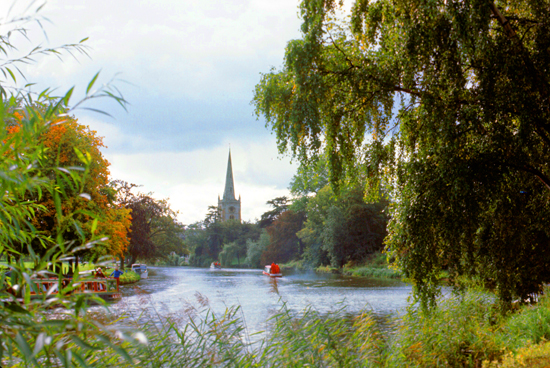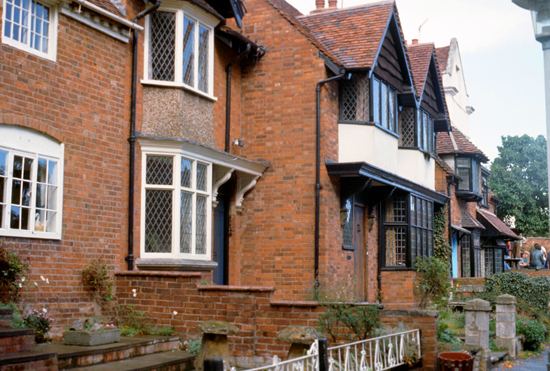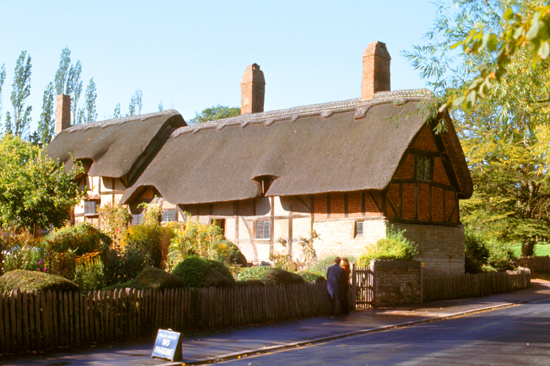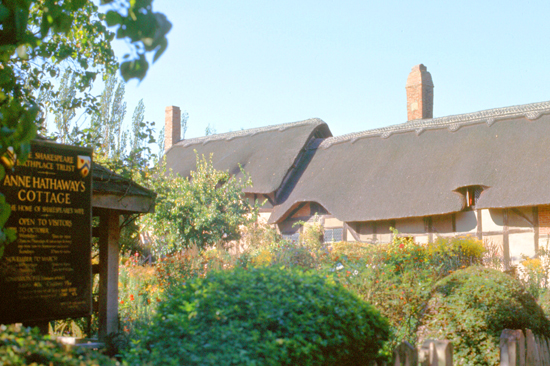
 |
Return to the Index Map for My Trip to England |
The class for Citibank was held in Lewisham, a close-in suburb of London. The trains to Lewisham run from Charing Cross also. The suburb itself is a little grimy and run-down, but the bank's facilities are quite nice. They are a new, tallish building right in the center of the suburb, easy walking distance from the train station. The trip took about an hour, hotel to bank. We had class for five days altogether.
On the Saturday after my class, I took a day trip from London to Stratford-upon-Avon. Not only would a visit here allow me to experience what living in England's countryside is like, but I would get to say that I visited Shakespeare's birthplace. (If you don't mind, just to make this page easier to write, I'll refer to Stratford-upon-Avon simply as "Stratford", so long as you understand there are other towns in England with basically the same name.)
On the page that brought you here, you've already seen that Stratford is about 100 miles from London to the northwest. I inquired at the front desk during the week as to how to get there, and I was advised that I could catch any number of trains that would take me towards Worcester with a change of trains to get into Stratford. Following the advice of the hotel concierge, I headed over to Charing Cross station and simply went over to the ticket window and asked for the quickest way to get there. It turned out that I could leave around eight-thirty and, after a 2+ hour trip, get into Stratford well before lunch. The return train would be in the very late afternoon, and would get me back to London by eight or so.
|
When I arrived at the station, I was certainly not alone; there were lots of other tourists here as well. But the weather was iffy, and I can only imagine that it would have been much more crowded had it been a really nice day in the spring or summer. When I left the station, I followed the signs to walk into Stratford via Alcester Road and Greenhill Street. I have put an aerial view of Stratford at left so you can get the layout of the town, but other than that view, I didn't think that any more aerial views would have added much to the narrative. Right at the intersection of Alcester and Greenhill, I came to an information center right next to a large fountain and tower.
|
Victorian Gothic in style, the fountain, which no longer provides water, is constructed mostly from Peterhead granite and freestone, resembling a small gothic cathedral of sorts, complete with a set of bells designed by JA Cossin's of Birmingham and a clock above each face of which sits a caricature of a fairy from Shakespeare's play A Midsummer Night's Dream.
I stopped in to the information center to pick up a little pamphlet that described the things to see and do in Stratford. Of course I wanted to see Shakespeare's birthplace and the River Avon, but the pamphlet also mentioned the Holy Trinity Church and Ann Hathaway's cottage as places worth a visit. I had plenty of time to see everything, so I headed off up Henley Street to the birthplace.
First a bit about the town itself. Stratford-upon-Avon, commonly known as just Stratford, is a market town and civil parish in the county of Warwickshire, on the River Avon, 91 miles northwest of London and 22 miles southeast of Birmingham. About 20,000 people live in the town and environs.
Stratford was originally inhabited by Anglo-Saxons and remained a village before the lord of the manor, John of Coutances, set out plans to develop it into a town in 1196. In that same year, Stratford was granted a charter from King Richard I to hold a weekly market in the town, giving it its status as a market town. As a result, Stratford experienced an increase in trade and commerce as well as urban expansion. Today, the town is a popular tourist destination owing to its status as birthplace of English playwright and poet William Shakespeare, and receives approximately 2 million visitors a year. The Royal Shakespeare Company resides in Stratford's Royal Shakespeare Theatre.
|
The house itself is relatively simple, but for the late 16th century it would have been considered quite a substantial dwelling. John Shakespeare, William's father, was a glove maker and wool dealer, and the house was originally divided in two parts to allow him to carry out his business from the same premises.
The building is not outstanding architecturally, and typical of the times was constructed in wattle and daub around a wooden frame. Local oak from the Forest of Arden and blue-grey stone from Wilmcote were used in its construction, while the large fireplaces were made from an unusual combination of early brick and stone, and the ground-floor level has stone-flagged floors.
The plan of the building was originally a simple rectangle. From northwest to southeast, the ground-floor consisted of a parlor with fireplace, an adjoining hall with a large open hearth, a cross passage, and finally a room which probably served as John Shakespeare's workshop.
|
But is this really Shakespeare's birthplace? Well, first of all, there are differing views concerning the origin of the building, which possibly dates back to the 1400s, but more likely was built in the mid-1500s.
Records show that in 1552 John Shakespeare was fined for leaving a pile of muck outside his home in Henley Street, proving that he resided in a house there at the time. In Jephson's account of Shakespeare's time in Stratford he states that at the time of Shakepeare's birth his father was renting the property and that ten years later he was able to purchase two freehold houses in Henley Street. Again according to some records, the house remained in the family until it was handed down for the final time to William Shakespeare’s daughter and, given that he was born in 1564, it is fairly certain that he was born and brought up there.
So, OK, I was actually in the building where Shakespeare was born and, to go even further, stuck my head into the very room where his mother gave birth (you couldn't actually go in that room). There was some furniture there, and even a simple crib, but I think it would be stretching credulity to think that any of the furniture that was in the house in the 1550s still exists.
|
The Guild Chapel is of 13th century origins. Founded by the Guild of the Holy Cross before 1269, it passed into the control of the town corporation in 1553, when the Guild was suppressed by Edward VI. The chapel stands on Church Street, opposite the site of William Shakespeare's home, New Place, and has historic connections to Shakespeare's family. The chapel was gifted an extensive series of wall-paintings by Hugh Clopton, an earlier owner of New Place, and John Shakespeare, Shakespeare's father, undertook their defacement in the later 1500s. The paintings have recently been conserved.
Clopton undertook a major expansion of the chapel before his death in 1496, constructing a new nave which was incomplete when he died. The chapel is currently being restored in a thirty-year programme undertaken by Stephen Dykes Bower in 1954. The Chapel is owned and maintained by the Stratford-upon-Avon Town Trust.
I was actually on my way to the house known as Shakespeare's New Place, which turned out to be on the corner just before the Guild Chapel, ahead of me at the corner of Church Street and Church Lane. New Place was William Shakespeare's final place of residence in Stratford-upon-Avon. He died there in 1616. Though the house no longer exists, the site is owned by the Shakespeare Birthplace Trust, which maintains it as a specially-designed garden for tourists.
|
The house, built in 1483 by Sir Hugh Clopton, a wealthy London mercer and Lord Mayor, was apparently the second largest dwelling in the town. Built of timber and brick it had ten fireplaces, five handsome gables, and grounds large enough to incorporate two barns and an orchard. In 1496 he left New Place in his will to his great-nephew William Clopton I, beginning a long succession of transfers by will through the Cloptons, a sale to William Bott, and then a sale to one William Underhill, an Inner Temple lawyer, clerk of assizes at Warwick, and a substantial property holder in Warwickshire.
At his death in 1570, Underhill left New Place to his son, William Underhill II (d.1597), who in 1597 sold it to William Shakespeare for £60. William Underhill II died two months later, and it emerged that he had been poisoned by his eldest son and heir, Fulke Underhill (who either died or was hanged). What followed was a legal tangle, during which Fulke's property, including New Place, were forfeit to the Crown.
In 1602 the Court of Exchequer performed an inquiry and decided to regrant the elder Underhill's property to Hercules Underhill, the younger son, and which point the sale to Shakespeare was recorded and made official.
|
You can't really see it in this picture, but attached to this building at the rear is the actual Royal Shakespeare Theatre that is the performance venue for the Company when they are in residence in Stratford.
There was a place near the Company building where I could walk over close to the banks of the River Avon and have a look to the south.
 Here is an iconic view of the River Avon and the Holy Trinity Church in the distance. |
 Walking south to the church, I passed some typical row houses here in Stratford. |
I was actually able to walk right along the river for a good ways, as there was a pedestrian path alongside the road going south. This road took me right to Holy Trinity Church.
|
The building dates from 1210 and is built on the site of a Saxon monastery. It is Stratford's oldest building, is situated on the banks of the River Avon, and is one of England's most visited churches. In the fourteenth century, John de Stratford founded a chantry, which was rebuilt between 1465 and 1491 by Dean Thomas Balshall, who is buried at the Church. The building is believed to have originally had a wooden spire, which was replaced by William Hiorne in 1763.
Holy Trinity contains many interesting features, including a 14th-century sanctuary knocker in the church's porch (built c. 1500), twenty-six 15th-century misericord seats in the chancel, with religious, secular and mythical carvings, and several large stained glass windows featuring major English and Biblical saints at the church's east and west ends.
The carved scenes of the life of Jesus around Balsall's tomb were mutilated during the Reformation, as were most images of Christ. Notable "survivors" include a remarkable face of Christ or possibly God the Father within a sedilia canopy, and some beautiful medieval stained glass depicting the Resurrection and Ascension of Christ and the Day of Pentecost. The pre-Reformation stone altar slab or mensa was found hidden beneath the floor in Victorian times and has now been re-instated as the High Altar.
William Shakespeare was baptised in Holy Trinity on 26 April 1564 and was buried there on 25 April 1616. The church still possesses the original Elizabethan register giving details of his baptism and burial, though it is kept by the Shakespeare Birthplace Trust for safekeeping. He is buried in the beautiful 15th-century chancel; Shakespeare was eligible to be buried in the chancel owing to his position as a "lay rector" of the church. Shakespeare's funerary monument is fixed on a wall alongside his burial place. The funerary monument was renovated in 1746 through proceeds from a production of Othello, the first recorded performance of a Shakespeare play in Stratford-upon-Avon.
Shakespeare would have come to Holy Trinity every week when he was in town, i.e. all through his childhood and on his return to live at New Place. His wife Anne Hathaway is buried next to him along with his eldest daughter Susanna.
|
Anne Hathaway's Cottage is a twelve-roomed farmhouse where Anne Hathaway, the wife of William Shakespeare, lived as a child in the village of Shottery, Warwickshire, England, about 1 mile west of Stratford-upon-Avon. Spacious, and with several bedrooms, it is now set in extensive gardens. The earliest part of the house was built prior to the 15th century; the higher part is 17th century. The house was known as Hewlands Farm in Shakespeare's day and had more than 90 acres of land attached to it; to call it a cottage is really a misnomer, as it is much larger than the term usually means. As in many houses of the period, it has multiple chimneys to spread the heat evenly throughout the house during winter. The largest chimney was used for cooking. It also has visible timber framing, typical of vernacular Tudor architecture. I thought it very photogenic, and took a couple of pictures:
 |
 |
After the death of Hathaway's father, the cottage was owned by her brother Bartholomew, and was passed down the Hathaway family until 1846, when financial problems forced them to sell it. However, it was still occupied by them as tenants when it was acquired in 1892 by the Shakespeare Birthplace Trust, which removed later additions and alterations. In 1969 the cottage was badly damaged in a fire, but was restored by the Trust and now open to the public as a museum. I did go inside, and found it interesting, even though all the interior furnishings are reproductions, and much of the arrangement based on speculation.
It was late in the afternoon by now, so I returned to the town square which was by now thronged with tourists. There, I just sat in the sunshine for a while, eventually going into a pub just off the square for something to drink and ended up getting a kind of meat pie as well. I walked leisurely back to the train station to catch my 7PM train back to London, where I arrived about 9PM in time to stop into a McDonald's on the way back to the Chelsea.
You can use the links below to continue to another photo album page.
 |
Return to the Index Map for My Trip to England |